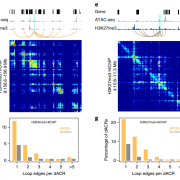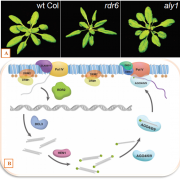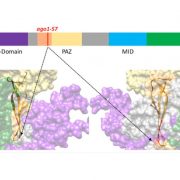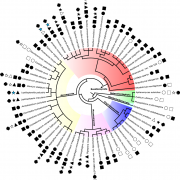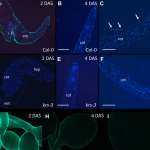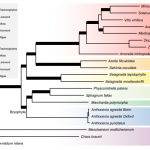Roles for CHROMATIN REMODELING 4 in Arabidopsis floral transition (Plant Cell)
 The time at which flowers appear is critical for plant reproductive success. As such, the vegetative to reproductive growth transition is governed by several cues: environmental (photoperiod, temperature) and endogenous (gibberellins, age). Here, Sang et al. used an elegant forward-genetics approach to identify uncharacterized regulators of the Arabidopsis endogenous flowering time pathways. A quintuple mutant (svp-41 flc-3 ft-10 tsf-1 soc1-2) was formed to ensure that floral initiation could only occur endogenously. In other words, the key regulators that induce flowering under high temperatures and long-day conditions were mutated. This quintuple mutant was further mutagenized and lines displaying late-flowering phenotypes were investigated. In this manner, CHROMATIN REMODELING 4 (CHR4) was identified as a positive regulator of floral transition. Immunoprecipitation experiments suggest that CHR4 functions in multimeric complexes with known regulators of floral meristem identity and transition such as the MADS, SPL and AP2 transcription factor families. Furthermore, in chr4 plants, ChIP-seq revealed several genomic loci that possess altered histone methylation patterns and RNA-seq showed that expression levels of various floral regulators are modified. Future studies will endeavor to determine the CHR4 mechanism of regulating gene expression. (Summary by Caroline Dowling) Plant Cell 10.1105/tpc.19.00992 (Image: Hanna Hõrak, The Plant Cell In Brief 10.1105/tpc.20.00196) [altmetric doi=”10.1105/tpc.20.00196″ details=”right” float=”right”]
The time at which flowers appear is critical for plant reproductive success. As such, the vegetative to reproductive growth transition is governed by several cues: environmental (photoperiod, temperature) and endogenous (gibberellins, age). Here, Sang et al. used an elegant forward-genetics approach to identify uncharacterized regulators of the Arabidopsis endogenous flowering time pathways. A quintuple mutant (svp-41 flc-3 ft-10 tsf-1 soc1-2) was formed to ensure that floral initiation could only occur endogenously. In other words, the key regulators that induce flowering under high temperatures and long-day conditions were mutated. This quintuple mutant was further mutagenized and lines displaying late-flowering phenotypes were investigated. In this manner, CHROMATIN REMODELING 4 (CHR4) was identified as a positive regulator of floral transition. Immunoprecipitation experiments suggest that CHR4 functions in multimeric complexes with known regulators of floral meristem identity and transition such as the MADS, SPL and AP2 transcription factor families. Furthermore, in chr4 plants, ChIP-seq revealed several genomic loci that possess altered histone methylation patterns and RNA-seq showed that expression levels of various floral regulators are modified. Future studies will endeavor to determine the CHR4 mechanism of regulating gene expression. (Summary by Caroline Dowling) Plant Cell 10.1105/tpc.19.00992 (Image: Hanna Hõrak, The Plant Cell In Brief 10.1105/tpc.20.00196) [altmetric doi=”10.1105/tpc.20.00196″ details=”right” float=”right”]


